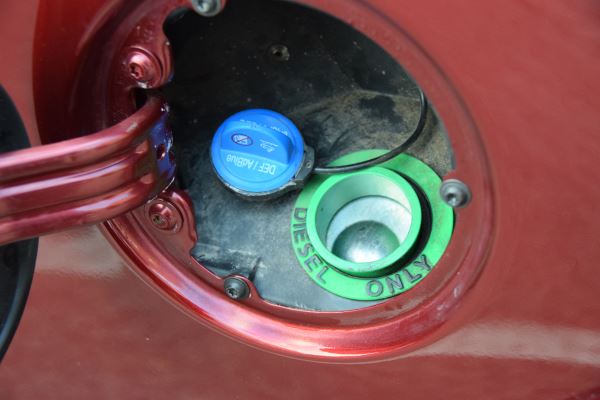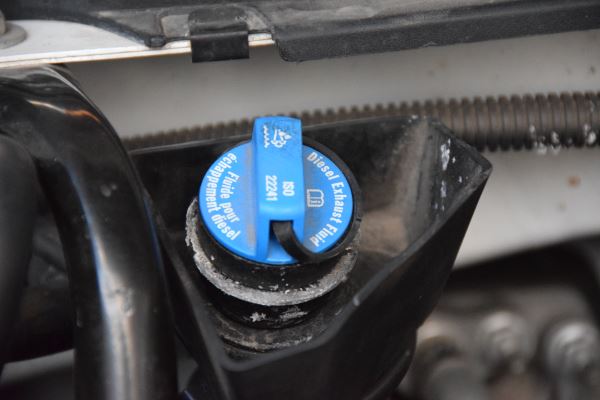If you haven’t driven a diesel pickup manufactured in 2010 or later, you might not be familiar with the terms DEF and SCR. In 2010, the US Environmental Protection Agency implemented a new set of emissions regulations that put a big cap on nitrous oxides (NOx) out of diesel tailpipes. In meeting these regulations, many manufacturers had to develop a selective catalytic reduction (SCR) system for their vehicles, which uses diesel exhaust fluid (DEF), a urea- and water-based solution available at pumps, to further treat exhaust gas that flows through the diesel particulate filter (DPF). DPFs have been used on highway diesel vehicles since 2007, but they did not completely eradicate NOx emissions between then and 2010. DPFs alone mostly filter out particulate matter, or soot.
What Is NOx And Why Is It a Big Deal?
Nitrous oxides (not to be confused with nitrous oxide) are simply compounds of nitrogen dioxide (NO2) and carbon dioxide (CO2). They contribute to smog and acid rain, along with a multitude of health problems almost as serious as those that stem from particulate matter. For example, NOx might worsen such pre-existing medical conditions as bronchitis and asthma. NOx is produced in the presence of nitrogen during combustion. This is very much the case for a diesel engine. Diesels have high compression ratios because there is an abundance of nitrogen in the air we breathe, which gets drawn into the engine for combustion.
Basic SCR Operation
The SCR system is more complex than just a DPF on top of an exhaust gas recirculation (EGR) system. After the exhaust gases pass through the DPF, they become converted to NO2 and CO2. In SCR systems, though, they also enter a decomposition reactor which sprays your DEF on it, thus producing ammonia with the NOx. The gases enter an SCR catalyst where they react to form a harmless combination of nitrogen and water vapor, reducing emissions to near-zero levels. Many diesel owners look down upon these systems, as they can significantly hamper performance.
Ups & Downs Of SCR Systems

Believe it or not, SCR systems can actually have some benefits. They don’t require DPF regeneration as often as exhaust systems on trucks built between 2007 and 2010. They also generate less soot in the DPF and improve fuel economy by up to five percent, making 2011 and newer trucks better for long-haul trips. SCR systems allow the engine to run at its optimum range in regard to fuel mixture; other systems make the engine run too rich, and that can hurt it. The biggest downside to SCR systems, though, is that they require lots of attention.
The DEF must be filled regularly in a small tank. Depending on the model, the tank is located in different places, such as under the hood or behind the fuel door next to the fuel port. This system can hurt your engine if not used properly. Sometimes, individuals might make the mistake of putting DEF in the diesel tank, which can inflict serious system and engine damage. Just remember that the DEF filler cap is the [smaller] one!
Not to worry, the EPA requires all SCR-equipped vehicles to have warnings that inform the driver when the DEF tank is almost empty. The DEF tanks are tamper-proof, and the vehicles also utilize sensors which keep drivers from using the wrong water-urea agents for their DEF. Before you buy an SCR-equipped vehicle, though, there are many other factors to consider, including the added weight of the DEF to the truck, the extra cost of DEF itself, system maintenance, heating your garage above 12 degrees Fahrenheit to keep your DEF from freezing, and, of course, disruption of performance if the DEF tank isn’t refilled. If you tow a lot of heavy loads or do a lot of stop-and-go driving, you’ll need to refill your tank more often.
Light On? Add DEF!
When your DEF level drops below 10 percent, you will see an amber warning light come on. At five percent, the light starts flashing. Then at 2.5 percent, you see a solid amber warning light. In this respect, you should treat your DEF like it’s your fuel. When your warning light comes on, don’t take any chances to make it to your destination. Refill your DEF as soon as possible. You’ll know you’ve run out when a solid red warning comes on and engine power reduces. Eventually, your truck will either be restricted to 5 mph or your engine will shut down in the middle of the road, both of which are dangerous and terrifying situations. The specific behavior of each vehicle varies when this happens; this is simply a general idea of what drivers can experience.
Power Stroke SCR
The EGR system on 2011 and newer Ford pickup trucks with the 6.7L Power Stroke engine is not so problematic as the one on the 6.4L and 6.0L engines. That’s thanks in part to the effectiveness of the SCR system used with this engine. This Bosch-manufactured SCR system works with a lower-duty EGR cycle than those of this engine’s predecessors. That helps increase the engine’s DEF range to around 7,500 miles depending on how the customer uses the truck. Another great feature on the Super Duty trucks is an included DEF heater to keep your DEF from freezing. The first warning comes when the truck reaches roughly the last 800 miles before the fluid runs out.
However, the 6.7L Power Stroke still has fairly common turbo issues that can be aggravated by the SCR system. It’s mostly been due to Ford using a turbo too small to draw in the amount of air required for pickup applications. This mainly happens when the turbo is being overworked, but that problem can be solved if you buy an aftermarket replacement turbo. When an SCR component fails on the 6.7L Power Stroke, it can be very expensive to replace.
Cummins SCR
SCR systems first became required for Cummins-powered RAM pickups for the 2013 model year. On these trucks, just like on the 2011 and newer Fords, the SCR system reduces the amount of both EGR and DPF regeneration cycles. For the 2013 model year, it also brought horsepower up to 385 and torque up to 850 pound-feet. The SCR system also improved fuel economy by 10 percent. To help maintain these ratings, these trucks received dual transmission coolers, dual radiators, a larger capacity EGR system, and a higher-efficiency fan. With all of that, a tank of DEF should regularly last roughly the same length as an oil change interval on these trucks. The Cummins, however, can be very sensitive to contamination if you aren’t careful when refilling your DEF. As long as the DEF is not contaminated and is changed according to schedule, the Cummins SCR system should not be very problematic.
Duramax SCR

As with the release of the Ford 6.7L Power Stroke, SCR technology became required for the 2011 model year on the newly-released LML Duramax 6.6L diesel in Chevrolet and GMC heavy-duty pickups. With the LML engine came what’s known as “9th injector” technology, which supplies fuel to the DPF during regeneration. With that, drivers don’t have to worry about cylinder washing and can safely use B20 biodiesel if they so desire. The SCR technology on this engine allows for highly beneficial engine calibration to be performed. Like its competitors, it saves fuel over DPF-equipped exhaust by using low-duty cycle DPF regeneration. While the cost of DEF offsets that, fuel and fluid costs are no more expensive than that of their LMM Duramax-powered predecessors. Under normal conditions, the DEF tank should be refilled roughly every 5,000 miles. Also, unlike its competitors, GM’s DEF cap is underneath the hood as opposed to being right next to the fuel cap, making it easy to avoid putting the wrong fluid in the wrong tank.
Many 2011 and newer Duramax-powered trucks suffer ongoing problems with their SCR systems, which include various sensor and pump failures as well as fluid freezing in cold weather. The most persistent problem was NOx sensor failures; this prompted GM to update their sensors and increase their warranty to 10 years or 110,000 miles. It is important to note, though, that not all 2011 models are covered by this change, so you might think twice if you’re looking to buy a used 2011 Duramax-powered Silverado or Sierra.
Current State Of SCR
Overall, today’s tightening diesel emissions regulations continue to make it harder to genuinely boost performance on pickup trucks, but overall, SCR technology is actually improving the performance of diesel engines by a small scope over those in 2007-2010 model trucks. If you can bear the extra cost of DEF and have a heated space to store your truck, then a 2011 or newer Ford, Chevy, or GMC or a 2013 or newer RAM pickup might be beneficial. If you don’t have an easy way of keeping your DEF tank warm, though, you may want to think harder before buying such a truck. With all the warnings in place on diesel vehicles, it’s easier to remember to fill up the DEF. If you’ve heard bad things about or experienced problems with DPF-equipped exhaust systems of 2007-2010 pickups before, don’t let that discourage you from buying 2011 or newer diesels!
[Sources]
Cummins Hub
www.cumminshub.com
Duramax Hub
www.duramaxhub.com
Hard Working Trucks
www.hardworkingtrucks.com
Powerstroke Hub
www.powerstrokehub.com
Ryder Blog
www.blog.ryder.com